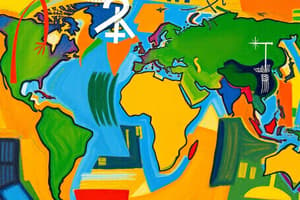Podcast
Questions and Answers
What is globalisation primarily defined as?
What is globalisation primarily defined as?
- The expansion of local businesses into nearby markets
- The government intervention in international trade
- The integration of world markets through technological advances (correct)
- The reduction of trade barriers only
International business has no impact on the economy of a country.
International business has no impact on the economy of a country.
False (B)
Name one positive impact of globalisation on countries.
Name one positive impact of globalisation on countries.
Increased market access
The __________ advantage theory suggests that a country should specialize in producing goods it can make more efficiently than others.
The __________ advantage theory suggests that a country should specialize in producing goods it can make more efficiently than others.
Which entry mode allows shared ownership and risks between two or more firms?
Which entry mode allows shared ownership and risks between two or more firms?
Match the following entry modes with their descriptions:
Match the following entry modes with their descriptions:
Small firms typically begin their internationalisation process with wholly owned subsidiaries.
Small firms typically begin their internationalisation process with wholly owned subsidiaries.
What does David Ricardo's comparative advantage theory suggest?
What does David Ricardo's comparative advantage theory suggest?
What is a key characteristic of emerging markets?
What is a key characteristic of emerging markets?
Multinational corporations operate only within their home countries.
Multinational corporations operate only within their home countries.
What economic strategy do firms use to mitigate risks related to currency fluctuations?
What economic strategy do firms use to mitigate risks related to currency fluctuations?
Japan's comparative advantage in electronics arises from a skilled workforce and __________.
Japan's comparative advantage in electronics arises from a skilled workforce and __________.
Match the following strategies of MNCs with their descriptions:
Match the following strategies of MNCs with their descriptions:
What type of legal system is based on precedent?
What type of legal system is based on precedent?
Tariffs are used to increase the quantity of imports.
Tariffs are used to increase the quantity of imports.
Name one of Hofstede's cultural dimensions.
Name one of Hofstede's cultural dimensions.
Corporate Social Responsibility (CSR) encompasses a company's economic, legal, and ethical obligations to __________.
Corporate Social Responsibility (CSR) encompasses a company's economic, legal, and ethical obligations to __________.
Which of the following best describes the trade evolution reflected in the Product Life Cycle theory?
Which of the following best describes the trade evolution reflected in the Product Life Cycle theory?
All emerging markets share similar characteristics and challenges.
All emerging markets share similar characteristics and challenges.
What is one example of a BRIC economy?
What is one example of a BRIC economy?
Government interventions like subsidies are primarily aimed at protecting __________ industries.
Government interventions like subsidies are primarily aimed at protecting __________ industries.
Match the following types of political systems with their descriptions:
Match the following types of political systems with their descriptions:
Flashcards
Globalization
Globalization
The process of integrating global markets through advancements in technology, reduced trade barriers, and converging consumer preferences.
International Business
International Business
The exchange of goods, services, and resources across national borders.
Absolute Advantage
Absolute Advantage
The theory that a country should specialize in producing goods it can create more efficiently than others.
Comparative Advantage
Comparative Advantage
Signup and view all the flashcards
Heckscher-Ohlin Model
Heckscher-Ohlin Model
Signup and view all the flashcards
Exporting
Exporting
Signup and view all the flashcards
Licensing
Licensing
Signup and view all the flashcards
Franchising
Franchising
Signup and view all the flashcards
Product Life Cycle theory
Product Life Cycle theory
Signup and view all the flashcards
Emerging Markets
Emerging Markets
Signup and view all the flashcards
MNC Strategies
MNC Strategies
Signup and view all the flashcards
Totalitarian Regime
Totalitarian Regime
Signup and view all the flashcards
Common Law System
Common Law System
Signup and view all the flashcards
Civil Law System
Civil Law System
Signup and view all the flashcards
Expropriation Risk
Expropriation Risk
Signup and view all the flashcards
Government Intervention in Trade
Government Intervention in Trade
Signup and view all the flashcards
Tariffs
Tariffs
Signup and view all the flashcards
Import Quotas
Import Quotas
Signup and view all the flashcards
Government Subsidies
Government Subsidies
Signup and view all the flashcards
Individualism vs Collectivism
Individualism vs Collectivism
Signup and view all the flashcards
Power Distance
Power Distance
Signup and view all the flashcards
Corporate Social Responsibility (CSR)
Corporate Social Responsibility (CSR)
Signup and view all the flashcards
Sustainability
Sustainability
Signup and view all the flashcards
Study Notes
International Business and Globalization
- International business involves cross-border trade of goods, services, and resources, driven by globalization.
- Globalization integrates world markets through technology (communication, transport), economic liberalization (reduced trade barriers), market convergence (consumer preferences), and cost drivers (economies of scale, outsourcing).
- Positive impacts include increased market access, innovation, and economic growth.
- Negative impacts include environmental degradation and income disparities.
- Globalization progresses through stages: market participation, supply chain integration, and economic interdependence.
Alternative Routes to Internationalization
- Firms internationalize using various entry modes with varying benefits and risks.
- Exporting (direct and indirect) allows market access without significant investment.
- Licensing grants foreign firms usage rights to technology/processes.
- Franchising transfers a complete business model to another country.
- Joint ventures involve shared ownership and risk among firms.
- Wholly owned subsidiaries represent full foreign investment, offering control but requiring resources.
- Entry mode choices depend on market size, risk tolerance, and resources. Small firms often start with indirect exporting.
Theories of International Trade
- Trade theories explain why countries engage in trade.
- Absolute advantage theory (Smith): Countries specialize in goods produced more efficiently.
- Comparative advantage theory (Ricardo): Countries benefit by focusing on goods with lower opportunity costs.
- Heckscher-Ohlin model: Trade patterns based on factor endowments (labor, capital).
- Product Life Cycle theory: Trade evolution from innovation to standardization.
- New trade theories highlight economies of scale and monopolistic competition (product differentiation).
Overview of Emerging Markets
- Emerging markets are economies transitioning toward industrialization and modernization.
- Marked by rapid GDP growth, a burgeoning middle class, and government influence.
- Emerging markets offer expansion opportunities and access to resources.
- Risks include political instability and regulatory challenges.
- BRIC economies (Brazil, Russia, India, China) are important to global trade.
- Challenges in emerging markets include infrastructure deficits and fluctuating regulations.
MNCs and Their Strategies
- Multinational corporations (MNCs) operate globally and adapt strategies for diverse markets.
- Global strategies emphasize standardization for cost efficiency.
- Transnational strategies balance global integration and local responsiveness.
- Multi-domestic strategies customize products for local preferences.
- MNC challenges include cultural differences, complex supply chains, and political risks.
- Successful MNCs adapt strategies to individual market dynamics.
Political and Legal Foundations
- Political and legal environments shape international business operations.
- Political systems range from democracies (market-friendly) to totalitarian regimes.
- Legal systems include common law, civil law, and religious law.
- Political risks include expropriation, trade barriers, and nationalization.
- Companies must assess market stability and regulatory frameworks.
Government Intervention
- Governments intervene in trade to safeguard domestic industries, ensure security, and foster economic growth.
- Instruments include tariffs, quotas, and subsidies.
- Interventions can protect local economies but lead to inefficiencies and disputes.
- Businesses must understand government policies to adapt their strategies.
Cultural Environment of IB
- Cultural differences significantly impact international business.
- Hofstede's cultural dimensions (individualism/collectivism, power distance) explain these differences.
- Individualistic societies prioritize personal goals, collectivist cultures value group harmony.
- High power distance societies accept hierarchy, low power distance cultures value equality.
- Businesses adapt to local cultures to enhance negotiations & partnerships.
Ethics, CSR, and Sustainability
- Ethical principles guide international business decision-making.
- Corporate Social Responsibility (CSR) encompasses economic, legal, and ethical obligations.
- CSR often involves supporting local communities and reducing environmental impact.
- Sustainability prioritizes present needs without compromising future generations.
- Ethical practices build stronger reputations and contribute to long-term success.
International Monetary and Financial Environment
- The international monetary system includes fixed and floating exchange rate regimes.
- Fixed rates are pegged to another currency for stability, floating rates fluctuate based on market conditions.
- Institutions like the IMF and World Bank provide financial stability.
- Financial risks include currency fluctuations and interest rate changes.
- Businesses use hedging to mitigate financial risks.
Studying That Suits You
Use AI to generate personalized quizzes and flashcards to suit your learning preferences.




